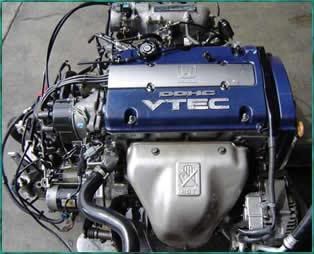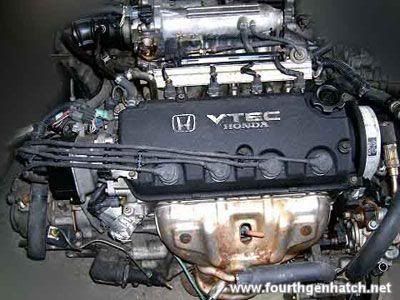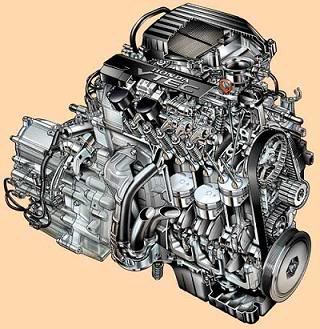- 分享
- 0
- 人气
- 0
- 主题
- 4
- 帖子
- 3592
- UID
- 229418
- 积分
- 1964
- 阅读权限
- 19
- 注册时间
- 2009-5-21
- 最后登录
- 2018-2-1
- 在线时间
- 592 小时
        
|
到最后就是讨论,Honda新一代宠儿
I-VTEC,就是用先进的技术开发出来的引擎....
I=智慧型.....
现在大部分的Honda都是使用I-VTEC 引擎,大家都误会 I-VTEC的引擎没"力"
没力的原因是因为 I-VTEC是使用人工智慧系统在控制,以防汽车出现"提升用油量"太多.导致车好像不去...
但是他却能以高速行驶时,以低的耗油量来行驶....达到省油的功效...
好了废话不多,现在为大家解释 I-VTEC
I-VTEC
大众化的VTEC系统的在市场价值增长,本田适用于系统SOHC (Single Over Head Cam)引擎,分享入口和排气门的一个共同的camshaft。 是那Honda SOHC引擎只受益于在进气阀的VTEC机制。 这是因为VTEC要求第三中心rocker arm和cam lobe(为每入口和尾气边),并且在SOHC引擎,火花塞没有位于在二根尾气摇杆之间,离开VTEC的rocker arm室。 另外,在camshaft的中心lobe可能由入口或尾气只运用,限制VTEC对一边的特点。
然而,从在所有2009年Acura TL SH-AWD款介绍的J37A4 3.7L SOHC V6引擎开始, SOHC VTEC被合并了为与入口和排气门的使用。 入口和exhaust rocker shafts 包含主要和次要入口和exhaust rocker arms,分别。 主要rocker arms包含VTEC开关活塞,而次要rocker arms包含离合弹簧 期限" 主要" 不提到rocker arm 在低RPM引擎操作时强迫阀门下来。 相反,它提到包含VTEC开关活塞并且从rocker shaft接受油的rocker arm 。
K系列马达有i-VTEC系统的二种不同类型被落实。 第一是为象在RSX类型S的表现马达或TSX和其他是为在CR-V或Accord找到的经济马达。 表现i-VTEC系统基本上是相同的象B16A'的DOHC VTEC系统,入口和exhaust有3个cam lobes给每个cylinder。 然而valvetrain有roller rockers 和连续地易变的入口cam timing的增加的好处。 经济i-VTEC就好像SOHC VTEC-E因为入口cam只有two lobes,一个非常小和一个大,并且没有VTEC在尾气cam的。 马达的二种类型由输出的工厂标定功率容易地是可区分的: 由工厂制造表现马达大约在200马力(150 kW)或经济的马达不做超过160马力(120 kW)内。
在2004年,本田介绍了i-VTEC V6 (J系列的更新),但是在这种情况下, i-VTEC与cam phasing采用无关。 反而, i-VTEC提到了Honda' s cylinde在轻的装载和低速的钝化技术(在80 km/h以下)操作时关闭在堤(3)cylinde的valves。 技术最初被介绍了给了美国的Honda Odyssey微型货车的,现在可能找到Honda Accord Hybrid的是、2006年本田Pilot,和2008年Honda Accord。
另外的版本的i-VTEC被使用在2006年Honda Civics R系列的四缸SOHC引擎。 这实施使用所谓的" economy cams" 在每个cylinde二个intake valves之一。 " economy cams" 被设计延迟他们行动进气阀的关闭和被激活在低rpms和在轻的装载之下。当" economy cams" 启动后,在活塞开始移动向上压缩冲过程中,每两个intake Valves进个一个Cylinder 然后再好好的关闭。 那个方式,进入了燃烧箱混合物的部分再被驱逐,入intake mainfold。 那个方式,引擎"齐位" 一个更低的位移比它实际一个(它的操作也类似一个Atkinson周期引擎,与参差不齐的压缩和燃烧冲程),减少燃料消费并且增加它的效率在操作时"economy cams" (由导线)throttle butterfly 收留充分地开放,为了减少pumping损失。 根据本田估计,只是这项措施可能减少pumping损失16%。 在更高的rpms和在重载之下,回到它的"的引擎开关 normal cams" 和经他操作规则的4 stroke Otto 引擎。 i-VTEC的R18A1引擎最初被使用在第8代的Honda Civic,与1.8升和140 PS (103 kW产品的位移; 138马力)。 最近,发布了另一个变形,与150 PS (110 kW产品的2.0升R20A2; 148马力),供给全新CRV动力的EUDM版本。
现在有很多极大不同的i-VTEC系统的持续的引进,本田有个也许的假设,将来不久可以研发拥有更创造性的valve control technologies.

以下是原文,因为怕翻译中有错误
i-VTEC (intelligent-VTEC)[3] introduced continuously variable camshaft phasing on the intake cam of DOHC VTEC engines. The technology first appeared on Honda's K-series four cylinder engine family in 2001 (2002 in the U.S.). In the United States, Honda first debut the technology on the 2002 Honda Civic Si EP3 with the economy version.
Valve lift and duration are still limited to distinct low- and high-RPM profiles, but the intake camshaft is now capable of advancing between 25 and 50 degrees (depending upon engine configuration) during operation. Phase changes are implemented by a computer controlled, oil driven adjustable cam gear. Phasing is determined by a combination of engine load and rpm, ranging from fully retarded at idle to somewhat advanced at full throttle and low rpm. The effect is further optimization of torque output, especially at low and midrange RPM.
The K-Series motors have two different types of i-VTEC systems implemented. The first is for the performance motors like in the RSX Type S or the TSX and the other is for economy motors found in the CR-V or Accord. The performance i-VTEC system is basically the same as the DOHC VTEC system of the B16A's, both intake and exhaust have 3 cam lobes per cylinder. However the valvetrain has the added benefit of roller rockers and continuously variable intake cam timing. The economy i-VTEC is more like the SOHC VTEC-E in that the intake cam has only two lobes, one very small and one larger, as well as no VTEC on the exhaust cam. The two types of motor are easily distinguishable by the factory rated power output: the performance motors make around 200 hp (150 kW) or more in stock form and the economy motors do not make much more than 160 hp (120 kW) from the factory.
In 2004, Honda introduced an i-VTEC V6 (an update of the J-series), but in this case, i-VTEC had nothing to do with cam phasing. Instead, i-VTEC referred to Honda's cylinder deactivation technology which closes the valves on one bank of (3) cylinders during light load and low speed (below 80 km/h) operation. The technology was originally introduced to the US on the Honda Odyssey minivan, and can now be found on the Honda Accord Hybrid, the 2006 Honda Pilot, and the 2008 Honda Accord.
An additional version of i-VTEC was introduced on the 2006 Honda Civic's R-series four cylinder SOHC engines. This implementation uses the so-called "economy cams" on one of the two intake valves of each cylinder. The "economy cams" are designed to delay the closure of the intake valve they act upon, and are activated at low rpms and under light loads. When the "economy cams" are activated, one of the two intake valves in each cylinder closes well after the piston has started moving upwards in the compression stroke. That way, a part of the mixture that has entered the combustion chamber is forced out again, into the intake manifold. That way, the engine "emulates" a lower displacement than its actual one (its operation is also similar to an Atkinson cycle engine, with uneven compression and combustion strokes), which reduces fuel consumption and increases its efficiency. During the operation with the "economy cams", the (by-wire) throttle butterfly is kept fully open, in order to reduce pumping losses. According to Honda, this measure alone can reduce pumping losses by 16%. In higher rpms and under heavier loads, the engine switches back into its "normal cams", and it operates like a regular 4 stroke Otto cycle engine. This implementation of i-VTEC was initially introduced in the R18A1 engine found under the bonnet of the 8th generation Civic, with a displacement of 1.8 L and an output of 140 PS (103 kW; 138 hp). Recently, another variant was released, the 2.0 L R20A2 with an output of 150 PS (110 kW; 148 hp), which powers the EUDM version of the all-new CRV
With the continued introduction of vastly different i-VTEC systems, one may assume that the term is now a catch-all for creative valve control technologies from Honda.
一切资料都是来自wikipedia,本人只是做翻译,如果有不对的地方请见谅em0068
[ 本帖最后由 uchihajim 于 2009-7-12 11:50 PM 编辑 ] |
|







 IP卡
IP卡 狗仔卡
狗仔卡

 发表于 2009-7-11 01:31 AM
发表于 2009-7-11 01:31 AM


 收藏
收藏 提升卡
提升卡 置顶卡
置顶卡 沉默卡
沉默卡 喧嚣卡
喧嚣卡 变色卡
变色卡 显身卡
显身卡 )
)







